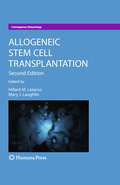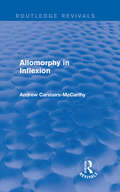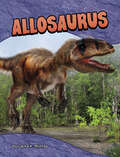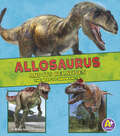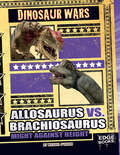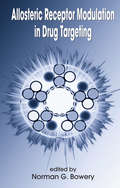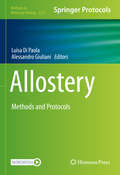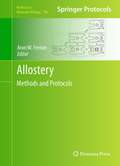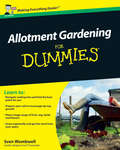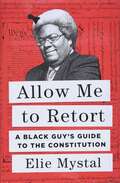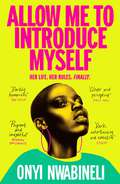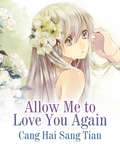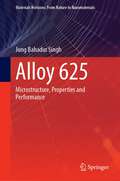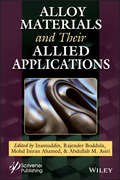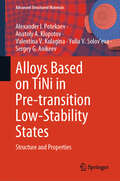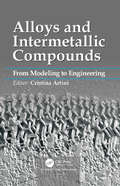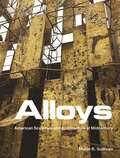- Table View
- List View
Allogeneic Stem Cell Transplantation: Clinical Research And Practice (Contemporary Hematology)
by Mary J. Laughlin Hillard M. LazarusSince the original publication of Allogeneic Stem Cell Transplantation: Clinical Research and Practice, Allogeneic hematopoietic stem cell transplantation (HSC) has undergone several fast-paced changes. In this second edition, the editors have focused on topics relevant to evolving knowledge in the field in order to better guide clinicians in decision-making and management of their patients, as well as help lead laboratory investigators in new directions emanating from clinical observations. Some of the most respected clinicians and scientists in this discipline have responded to the recent advances in the field by providing state-of-the-art discussions addressing these topics in the second edition. The text covers the scope of human genomic variation, the methods of HLA typing and interpretation of high-resolution HLA results. Comprehensive and up-to-date, Allogeneic Stem Cell Transplantation: Clinical Research and Practice, Second Edition offers concise advice on today's best clinical practice and will be of significant benefit to all clinicians and researchers in allogeneic HSC transplantation.
Allomorphy in Inflexion (Routledge Revivals)
by Andrew Carstairs-McCarthyFirst published in 1987, this book broke new ground in research on inflectional morphology. Drawing on evidence from a wide variety of languages, it shows that this is not just a phenomenon left over from obsolete phonological processes but a subject deserving of respect in its own right. The book proposes constraints in three areas: (1) the organization of inflection class systems; (2) inflectional homonymy, or syncretism; (3) the direction of allomorphic conditioning. Carstairs-McCarthy’s notion of ‘paradigm economy’ revolutionized the study of inflection class systems but in its purest form, presented in this book, the hypothesis was too strong. In more recent works, the author has therefore argued that a version of it is an unexpected by-product of the brain’s aptitude for handling multiple vocabularies. The study of inflectional homonymy was pioneered by Roman Jakobson as evidence for the structuring of morphosyntactic categories or feature sets (case, number, tense, mood and so on) but his approach differed from that of this book, whose radical suggestions fertilized much subsequent work on ‘inflectional identity’. The direction of conditioning, first explored in this text, is debated actively within the Distributed Morphology framework popular within Chomskyan generative linguistics, despite disagreement with the Carstairs-McCarthy view that morphology is a domain of grammar entirely distinct from syntax. In The Evolution of Morphology (2010) the author takes these topics further, and also explains why stem alternation and affixation are importantly distinct as modes of inflectional expression. Inflectional allomorphy is an apparently pointless complication exhibited by many languages. However, this book suggests reasons why it is, nevertheless, easy for the brain to handle. The work thus has important implications beyond language, extending into human cognition.
Alloran's Choice (Animorphs Companion: The Andalite Chronicles, #2)
by K. A. ApplegateElfangor's journey began with a simple mission, but his fellow 'aristh' makes a discovery that takes them all to their home world.
Allosaurus
by Laura K. MurrayAllosaurus ran on two feet and had razor-sharp teeth. But what did it hunt? And why did it have short, bony horns above its eyes? Young readers can get all the facts on this fierce meat-eating dinosaur. Engaging text and images make this book a great choice for information to use in a report or just to read for fun.
Allosaurus and Its Relatives: The Need-to-know Facts (Dinosaur Fact Dig Ser.)
by Megan Cooley PetersonAllosaurus and its relatives were fierce and dangerous predators. Dinosaurs in this group had deadly claws and razor-sharp teeth. Bold, full-color illustrations, easy-to-read charts and maps, and interesting facts take readers back to a time when these fearsome hunters walked the earth. This book supports common core standards.
Allosaurus vs. Brachiosaurus
by Michael O’Hearndinosaurs; battle; preditors; allosaurus; brachiosaurus
Allosteric Enzymes
by Guy HerveThis book compiles detailed information concerning a dozen of the best known allosteric enzymes, and so allows the comparison of their regulatory mechanisms and the confrontation of these mechanisms with the theoretical models. Stimulating and unexpected ideas emerge from these comparisons and emphasize the importance of developing various methods of investigation such as crystallography, X-ray solution scattering, and the study of fast movements in proteins and site-directed mutagenesis. This book is addressed to students and researchers interested in structure-function relationship in proteins, enzymology and metabolic regulation. It is also a basis for teaching.
Allosteric Receptor Modulation in Drug Targeting
by Norman G. BoweryOffering a wide array of illustrations and tables in every chapter, this book extensively covers the principles of allosterism in reference to drug action and progresses to a detailed examination of individual ionotropic and G-protein coupled receptor systems-helping those new to the subject understand the importance of allosterism and providing th
Allostery: Methods and Protocols (Methods in Molecular Biology #2253)
by Alessandro Giuliani Luisa Di PaolaThis volume explores the basic issues of “allostery” and “network” that are fundamental to studying this field. Chapters in this book look at how the basic “machine-like” proteins, that are similar to “human machines,” need to be organized, architecturally, to relate to different organizational layers. Chapters cover topics such as methodological/computational factors focused on links between allostery and network formalism; the presence of oscillating modes transversing the structure and underlying network wiring of the allosteric process; the “action at distance” by transduction of signals across an organized network structure; and the P53 protein located at the cross-road of cell cycle regulation, genome integrity, and cancer development. Written in the highly successful Methods in Molecular Biology series format, chapters include introductions to their respective topics, lists of the necessary materials and reagents, step-by-step, readily reproducible laboratory protocols, and tips on troubleshooting and avoiding known pitfalls.Thorough and practical, Allostery: Methods and Protocols is a valuable resource for any scientists and researcher interested in learning more about this developing field.
Allostery: Methods and Protocols (Methods in Molecular Biology #796)
by Aron W. FentonDespite considerable variability within the scientific community, allosteric regulation can best be defined functionally as how a macromolecule binds one ligand differently when a second ligand is or is not pre-bound to the macromolecule, which constitutes a vital aspect of protein structure/function. In Allostery: Methods and Protocols, expert researchers in the field provide key techniques to investigate this biological phenomenon. Focusing on heterotropic systems with some coverage of homotropic systems, this volume covers the monitoring of allosteric function, allosteric conformational changes, and allosteric changes in protein dynamics/sub-population distribution, as well as topics such as macromolecular and ligand engineering of allosteric functions and computational aids in the study of allostery. Written in the highly successful Methods in Molecular BiologyTM series format, the chapters include the kind of detailed description and implementation advice that is crucial for getting optimal results in the laboratory. Thorough and intuitive, Allostery: Methods and Protocols aids scientists in continuing to study ligand-induced, through-protein effects on protein function (ligand binding/catalysis), a phenomenon that is well recognized through the history of the life sciences and very poorly understood at the molecular level.
Allotment Gardening For Dummies
by Sven WombwellAllotment Gardening For Dummies is a lively, hands-on guide to getting the most out of your allotment. Whether you're interested in eating fresh, saving money, getting exercise or enjoying wholesome family fun, this is the guide for you. The step-by-step advice takes you through all the stages in the process, from securing an allotment and preparing your plot, to choosing what to grow and enjoying the benefits of abundant fresh food and a sociable and healthy hobby. With over 50 handy line drawings, plus information on how to grow organic and advice on storing and cooking the food you grow, this guide really does have it all!Allotment Gardening For Dummies includes:Part 1: Getting to Grips with Allotment GardeningChapter 1: What Are Allotments All About?Chapter 2: Getting hold of an AllotmentChapter 3: Getting StartedPart 2: Preparing for Allotment SuccessChapter 4: Deciding What to Grow, WhenChapter 5: Preparing Your PlotChapter 6: Keeping Your Soil HealthyChapter 7: Keeping Your Plants HealthyChapter 8: Growing OrganicPart 3: Growing a Few of Your Favourite VegetablesChapter 9: Going UndergroundChapter 10: The StaplesChapter 11: Growing Leafy GreensChapter 12: Planting Peas, Beans and Other PodsChapter 13: Growing More Exotic VegPart 4: Extending Your Allotment RepetoireChapter 14: Growing Wholesome HerbsChapter 15: Growing Fruitful FruitChapter 16: Nurturing Flowers on an AllotmentPart 5: Getting the Most Out of Your AllotmentChapter 17: Involving Children Around the AllotmentChapter 18: Hobnobbing with Allotment SocietyChapter 19: Growing Giant VegPart 6: The Part of Tens ChapterChapter 20: Ten Common Accidents and How to Prevent ThemChapter 21: Ten Ways to Revive a Flagging Allotment
Allotment Stories: Indigenous Land Relations under Settler Siege (Indigenous Americas)
by Jean M. O'Brien Daniel Heath JusticeMore than two dozen stories of Indigenous resistance to the privatization and allotment of Indigenous lands Land privatization has been a longstanding and ongoing settler colonial process separating Indigenous peoples from their traditional homelands, with devastating consequences. Allotment Stories delves into this conflict, creating a complex conversation out of narratives of Indigenous communities resisting allotment and other dispossessive land schemes.From the use of homesteading by nineteenth-century Anishinaabe women to maintain their independence to the role that roads have played in expropriating Guam&’s Indigenous heritage to the links between land loss and genocide in California, Allotment Stories collects more than two dozen chronicles of white imperialism and Indigenous resistance. Ranging from the historical to the contemporary and grappling with Indigenous land struggles around the globe, these narratives showcase both scholarly and creative forms of expression, constructing a multifaceted book of diverse disciplinary perspectives. Allotment Stories highlights how Indigenous peoples have consistently used creativity to sustain collective ties, kinship relations, and cultural commitments in the face of privatization. At once informing readers while provoking them toward further research into Indigenous resilience, this collection pieces back together some of what the forces of allotment have tried to tear apart.Contributors: Jennifer Adese, U of Toronto Mississauga; Megan Baker, U of California, Los Angeles; William Bauer Jr., U of Nevada, Las Vegas; Christine Taitano DeLisle, U of Minnesota–Twin Cities; Vicente M. Diaz, U of Minnesota–Twin Cities; Sarah Biscarra Dilley, U of California, Davis; Marilyn Dumont, U of Alberta; Munir Fakher Eldin, Birzeit U, Palestine; Nick Estes, U of New Mexico; Pauliina Feodoroff; Susan E. Gray, Arizona State U; J. Kēhaulani Kauanui, Wesleyan U; Rauna Kuokkanen, U of Lapland and U of Toronto; Sheryl R. Lightfoot, U of British Columbia; Kelly McDonough, U of Texas at Austin; Ruby Hansen Murray; Tero Mustonen, U of Eastern Finland; Darren O&’Toole, U of Ottawa; Shiri Pasternak, Ryerson U; Dione Payne, Te Whare Wānaka o Aoraki–Lincoln U; Joseph M. Pierce, Stony Brook U; Khal Schneider, California State U, Sacramento; Argelia Segovia Liga, Colegio de Michoacán; Leanne Betasamosake Simpson; Jameson R. Sweet, Rutgers U; Michael P. Taylor, Brigham Young U; Candessa Tehee, Northeastern State U; Benjamin Hugh Velaise, Google American Indian Network.
Allow Me To Retort: A Black Guy's Guide to the Constitution
by Elie MystalAllow Me to Retort is an easily digestible argument about what rights we have, what rights Republicans are trying to take away, and how to stop them. <p><p>Mystal explains how to protect the rights of women and people of color instead of cowering to the absolutism of gun owners and bigots. He explains the legal way to stop everything from police brutality to political gerrymandering, just by changing a few judges and justices. He strips out all of the fancy jargon conservatives like to hide behind and lays bare the truth of their project to keep America forever tethered to its slaveholding past. <p><p> Mystal brings his trademark humor, expertise, and rhetorical flair to explain concepts like substantive due process and the right for the LGBTQ community to buy a cake, and to arm listeners with the knowledge to defend themselves against conservatives who want everybody to live under the yoke of 18th-century White men. The same tactics Mystal uses to defend the idea of a fair and equal society on MSNBC and CNN are in this book, for anybody who wants to deploy them on social media. <p><p> You don’t need to be a legal scholar to understand your own rights. You don’t need to accept the “Whites only” theory of equality pushed by conservative judges. You can listen to this book to understand that the Constitution is trash but doesn’t have to be.
Allow Me to Introduce Myself
by Onyi Nwabineli'Dark, entertaining and addictive' Stylist, 'Best Books of May' 'Clever and perceptive' Daily Mail A Grazia 'Hot New Novel' pick' HER LIFE. HER RULES. FINALLY. A page-turning novel about the dark side of social media, perfect for fans of The List or How to Kill Your Family.Anuri Chinasa has had enough. She was the unwilling star of her stepmother&’s social media empire before 'mumfluencers' were even a thing. For years, Ophelia documented every birthday, every skinned knee, every milestone and meltdown for millions of strangers to fawn over and pick apart.Now twenty-five years old, Anuri is desperate to escape her public past and start living on her own terms. But so far, it&’s not going well. She can barely walk down the street without being recognised, her PhD application is still unfinished and her drinking problem is getting worse. She wants her stepmother out of her life, but Ophelia has made it very clear she won&’t let go without a fight. But when Ophelia starts pushing Anuri's five-year-old sister, Noelle, down a similar path, she reaches breaking point. Anuri won't watch history repeat itself. Allow Me to Introduce Myself is a darkly funny, heartfelt satire about the dangers of social media and the deceptive allure of the picture-perfect existence. 'Nwabineli is one to watch' Red Magazine
Allow Me to Introduce Myself: A Novel
by Onyi NwabineliHer life. Her rules. Finally.Anuri Chinasa has had enough. And really, who can blame her? She was the unwilling star of her stepmother&’s social media empire before &“momfluencers&” were even a thing. For years, Ophelia documented every birthday, every skinned knee, every milestone and meltdown for millions of strangers to fawn over and pick apart.Now, at twenty-five, Anuri is desperate to put her way-too-public past behind her and start living on her own terms. But it&’s not going so great. She can barely walk down the street without someone recognizing her, and the fraught relationship with her father has fallen apart. Then there&’s her PhD application (still unfinished) and her drinking problem (still going strong). When every detail of her childhood was so intensely scrutinized, how can she tell what she really wants?Still, Ophelia is never far away and has made it clear she won&’t go down without a fight. With Noelle, Anuri&’s five-year-old half sister now being forced down the same path, Anuri discovers she has a new mission in life…To take back control of the family narrative.Through biting wit and heartfelt introspection, this darkly humorous story dives deep into the deceptive allure of a picture-perfect existence, the overexposure of children in social media and the excitement of self-discovery.
Allow Me to Love You Again: Volume 1 (Volume 1 #1)
by Cang HaisangtianEight years ago of a misunderstanding changed the fate of the two a small boy by all discrimination become the president of the all-powerful eight years later he to eight years of humiliation design the bride she became his contract but she has been deeply in love with his heart kind suspicion lonely means high-handed etc these are actually shows his love for her has been to love and be love of two men for her and his brothers three men were deeply in love with her but her mind is only his existence no matter what he did and said what and even false betrayal she can forgive him thought after a storm comes a calm she was pregnant but another misunderstanding led to her abortion their love can continue can they still accept each other
Allowances for Corporate Equity in Practice
by Alexander KlemmA report from the International Monetary Fund.
Alloy 625: Microstructure, Properties and Performance (Materials Horizons: From Nature to Nanomaterials)
by Jung Bahadur SinghThis book gives a brief history of the development of Alloy 625 and a detailed account of its physical, mechanical, and corrosion properties. It also addresses different types of microstructural changes the Alloy 625 undergoes at intermediate temperatures; provides details of properties deterioration due to such microstructural changes; assesses the alloy damage during the in-service inspection of plants; and provides criteria for the damage evaluation for various destructive and non-destructive testing. It combines the industrial data and literature together in one place for damage assessment of service exposed Alloy 625 components. This book serves as a guide to practicing engineers in the industry interested in the use of Alloy 625 and in academia for students pursuing advanced courses in materials science. Alloy 625 is a versatile nickel-chromium-molybdenum alloy known for its unique combination of high strength, excellent fabricability and weldability, and outstanding corrosion resistance.
Alloy Materials and Their Allied Applications
by Inamuddin Abdullah M. Asiri Mohd Imran Ahamed Rajender BoddulaAlloy Materials and Their Allied Applications provides an in-depth overview of alloy materials and applications. The 11 chapters focus on the fabrication methods and design of corrosion-resistant, magnetic, biodegradable, and shape memory alloys. The industrial applications in the allied areas, such as biomedical, dental implants, abrasive finishing, surface treatments, photocatalysis, water treatment, and batteries, are discussed in detail. This book will help readers solve fundamental and applied problems faced in the field of allied alloys applications.
Alloy.com: Marketing to Generation Y
by John Deighton Gil McwilliamsA profitable dot com company? Alloy.com retails clothing to teens by catalog. Alloy uses a Web site to convert prospects and build community. The result is a business with the economics of a direct marketer and the market capitalization of an Internet start-up. The case presents the decision of whether to partner with AOL or to persevere with the current mix of customer acquisition methods.
Alloys Based on TiNi in Pre-transition Low-Stability States: Structure and Properties (Advanced Structured Materials #216)
by Alexander I. Potekaev Anatoly A. Klopotov Valentina V. Kulagina Yulia V. Solov'eva Sergey G. AnikeevThis book presents the results of research on the regularities during thermocyclic impact on changes in structural-phase states of functional alloys with low-stability or instability in the area of structural-phase transformations. Without clarification of the physical regularities of the influence of thermomechanical impact on the properties of alloys, it is impossible to develop technological processes of processing functional materials; therefore, the book widely uses the results of many years of research by the authors of the book. It is known that critical temperatures and stresses for martensitic transformation, for example, B 2↔︎ B 19′, in NiTi are very sensitive to cycling. The study of structural-phase states, corresponding to changes in physical-mechanical properties of intermetallics in the area of transformations, is a necessary aspect of understanding the nature of the influence of thermomechanical cycling on the properties of functional alloys. This book is dedicated to the fundamental physical aspects of stability, the influence of structural defects on properties and structural-phase transformations of FCC alloys. This book is useful for a wide range of specialists—scientific researchers and engineers, working in the field of materials science and physics of condensed systems, as well as teachers, postgraduates and students, specializing in the field of materials science.
Alloys and Composites of Polybenzoxazines: Properties and Applications (Engineering Materials)
by Chanchira Jubsilp Sarawut Rimdusit Sunan TiptipakornThis book provides an introduction to the unique and fascinating properties of alloys and composites from novel commercialized thermosetting resins based on polybenzoxazines. Their outstanding properties such as processability, thermal, mechanical, electrical properties as well as ballistic impact properties of polybenzoxazine alloys and composites make them attractive for various applications in electronic packaging encapsulation, light weight ballistic armour composites and bipolar plate in fuel cells.
Alloys and Intermetallic Compounds: From Modeling to Engineering
by Cristina ArtiniThis book focuses on the role of modeling in the design of alloys and intermetallic compounds. It includes an introduction to the most important and most used modeling techniques, such as CALPHAD and ab-initio methods, as well as a section devoted to the latest developments in applications of alloys. The book emphasizes the correlation between modeling and technological developments while discussing topics such as wettability of Ultra High Temperature Ceramics by metals, active brazing of diamonds to metals in cutting tools, surface issues in medicine, novel Fe-based superconductors, metallic glasses, high entropy alloys, and thermoelectric materials.
Alloys: American Sculpture and Architecture at Midcentury
by Marin R. SullivanA new look at the interrelationship of architecture and sculpture during one of the richest periods of American modern designAlloys looks at a unique period of synergy and exchange in the postwar United States, when sculpture profoundly shaped architecture, and vice versa. Leading architects such as Gordon Bunshaft and Eero Saarinen turned to sculptors including Harry Bertoia, Alexander Calder, Richard Lippold, and Isamu Noguchi to produce site-determined, large-scale sculptures tailored for their buildings’ highly visible and well-traversed threshold spaces. The parameters of these spaces—atriums, lobbies, plazas, and entryways—led to various designs like sculptural walls, ceilings, and screens that not only embraced new industrial materials and processes, but also demonstrated art’s ability to merge with lived architectural spaces.Marin Sullivan argues that these sculptural commissions represent an alternate history of midcentury American art. Rather than singular masterworks by lone geniuses, some of the era’s most notable spaces—Philip Johnson’s Four Seasons Restaurant in Mies van der Rohe’s Seagram Building, Max Abramovitz’s Philharmonic Hall at Lincoln Center, and Pietro Belluschi and Walter Gropius’s Pan Am Building—would be diminished without the collaborative efforts of architects and artists. At the same time, the artistic creations within these spaces could not exist anywhere else. Sullivan shows that the principle of synergy provides an ideal framework to assess this pronounced relationship between sculpture and architecture. She also explores the afterlives of these postwar commissions in the decades since their construction.A fresh consideration of sculpture’s relationship to architectural design and functionality following World War II, Alloys highlights the affinities between the two fields and the ways their connections remain with us today.
